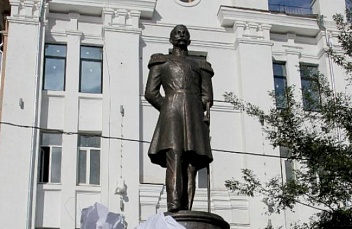
New Monuments of Russian Heroes of Russian-Circassian War Anger Circassians
Publication: Eurasia Daily Monitor Volume: 13 Issue: 179
By:

In October, authorities in the city of Krasnodar inaugurated a monument commemorating Cossack ataman and Lieutenant General Grigory Rashpil. The monument was erected to mark the 320th anniversary of the Kuban Cossack Military. Rashpil took an active part in the Russian conquest of the North Caucasus in the 19th century (Kavkazsky Uzel, October 16). The dedication of yet another monument of a Russian tsarist-era general in the North Caucasus (see EDM, September 26, 2013; May 30, 2015) reignited resentment among Circassian activists against the government policy of commemorating Russian heroes who are simultaneously despised by Circassians. General Rashpil was known among the Circassians as one of the “butchers of the Circassian people.” In 1841, Rashpil reportedly defended Russian settlements from an attack by the Abadzekhs (one of the Circassian tribes) in the Black Sea area. During 1850–1855, the Russian military commander took part in ravishing Circassian lands in an attempt to break their resistance (Onkavkaz.com, November 4).
Unlike in other parts of the North Caucasus, Russian tsars actively strived to efface the Circassians’ presence from their homeland. The reason for such brutal ethnic cleansing was that Moscow wanted to secure its access to the Black Sea coast. Hence, Russia’s long war with Shamil in the eastern part of the North Caucasus did not result in mass deportations or the elimination of the conquered peoples; whereas in the western part of the region, an estimated 90 percent of the Circassian population was either killed, starved to death, or deported. Moscow followed this up with a resettlement of ethnic Russians, Cossacks, and other friendly ethnic groups within months after Circassians were deported from their homeland. Although the Russian government maintains that those events should be relegated to the distant past, judging by its active policy of promoting monuments commemorating Russian heroes of the Russian-Circassian war, this history still has a high political salience. By erecting memorials to Imperial Russian generals and leaders, who killed and conquered Circassians, the Russian government—willingly or not—is intimidating today’s Circassian populations living in the Northwest Caucasus.
“The more indignation the oppressor’s figure evokes among us [Circassians], the more readily the authorities appear to be commemorating such people,” Circassian activists Aslan Beshto told the news agency Kavkaz-Realii. According to Beshto, the commemoration of the most notorious and brutal figures who participated in the Russian conquest of the western North Caucasus is becoming increasingly common. Memorials are created for the “Cossacks, who settled and made livable this wild place,” as if there had been no people and no culture before the arrival of Russians, Beshto said ironically. In 2003, the authorities inaugurated a monument of the notorious Russian General Grigory Zass, who was known as the “collector of Circassian skulls.” Another 19th century Russian general with a controversial reputation in the North Caucasus, Aleksei Yermolov, was honored by multiple monuments in the cities of Stavropol region, Moscow and elsewhere. The grand duke of Russia, Mikhail Romanov, was honored with a monument in Adygea in 2010, despite multiple protests by Circassian activists. As such, many Circassians are angry at what they see as an apparent government-sponsored campaign of renewed conquest (Kavkaz-Realii, November 3). The discontent among Circassians is further exacerbated by the fact they this group does not have nearly as many monuments dedicated to their heroes, as the Russians do. Circassian activist Aramby Khepai said: “There is not a single monument of the defenders of the [North] Caucasus or Circassia across the [North] Caucasus. My clan, which resided on the territory of the modern-day Republic of Adygea, was practically completely eliminated” (Onkavkaz.com, November 4).
Circassians, along with other peoples of the North Caucasus, would certainly like to install monuments featuring their own historical heroes. But apparently, Moscow is quietly but effectively discouraging them from doing so. Instead, the North Caucasus is full of monuments celebrating the friendship of Russians and locals, along with Soviet-era monuments of Vladimir Lenin and other Soviet figures.
The Circassian flag has, thus, become one of the alternative symbols for the Circassians. The Circassian green flag with crossed arrows and scattered stars often surfaces at gatherings of Circassians in Russia and around the world. Many Circassians are convinced that the role of a single flag to unite a divided nation has been exceptionally high. This green-and-gold banner became the official flag of the Republic of Adygea. Besides, Adygea, Kabardino-Balkaria, and Karachaevo-Cherkessia now officially celebrate the Day of the Circassian Flag on April 25 (Onkavkaz.com, October 30).
Despite the importance of the Circassian flag, however, it does not have the same property of stability and presence as stationary monuments. Given the Russian authorities’ activities in expanding the installation of monuments featuring Russian heroes and the outcry it causes among the Circassians, it is plausible to suggest that a “war of monuments” is likely to become unleashed in the region. Adygea is the most probable candidate to be such a “battleground” of monuments. The republic has a majority ethnic-Russian population, but its government is dominated by ethnic Circassians (Adygeans). Soon after Russians installed a statue of Russian Grand Duke Mikhail Romanov in Adygea, Circassians called for constructing a monument for their own hero—Haji-Kizbech Sheretluko, one of the most notable early 19th century leaders of the Shapsugs who successfully fought off the tsarist Russian army for some time (Aheku.net, March 27, 2014). Russians clearly wield much greater resources than the Circassians. Therefore, monuments to Russian heroes will almost certainly continue to “outpace” statues dedicated to figures from Circassian history, further disenfranchising the Circassian population in the Northwest Caucasus.



